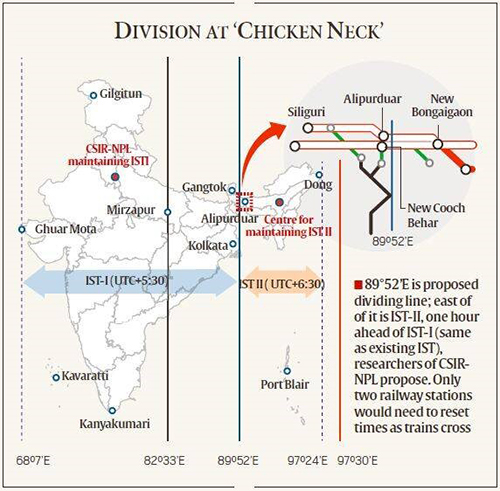Relevance: GS-1: Salient features of the World’s Physical Geography.
Key Phrases: Indian Standard Time (IST), Time Zones, Greenwich Mean Time (GMT), Universal Coordinated Time (UTC), Bagan Time, Daylight Saving Time, Council of Scientific & Industrial Research’s National Physical Laboratory (CSIR-NPL).
Why in News?
- USA spans 4,800 km from East to West and is divided into six time zones. In contrast, India stretches over 3,000 km from Gujarat to Arunachal Pradesh but has only one time zone.
- While there is a debate in the US about whether they should switch from six time zones to two, India, on the other hand, has been talking about moving from one time zone to two for a long.
- China also has one time zone.
Indian Standard Time (IST)
- Indian Standard Time is calculated based on 82.5 °E longitude which is just west of the town of Mirzapur, near Allahabad (now Prayagraj) in the State of Uttar Pradesh, which is five and a half hours ahead of Greenwich Mean Time (GMT), now called the Universal Coordinated Time (UTC) and this standard time zone is followed across India, even though the East to West expanse of the country approx.3000 km.
- Keeper of the time in India is the CSIR-National Physical Laboratory (NPL), New Delhi, which records time using five caesium atomic clocks.
- The time difference between the western-most part and the eastern-most point of India is approximately two hours, the effect of which is that the sun rises and sets much earlier in the North-East than it does in the rest of the country.
- The five states in India through which the standard
Meridian passes are:
- Uttar Pradesh;
- Madhya Pradesh;
- Chhattisgarh;
- Odisha; and
- Andhra Pradesh.

Single Time : Pros and Cons
- Pros:
- The proponents of a single time zone contend that India is not as large as China, which maintains a single time zone (the country spreads across five time zones).
- Implementing two time zones in India will cause havoc, not just in long-distance railway timetables but also in the way business is conducted. A single shared experience, no matter where you are in India, unites the country.
- Anyone who is traveling in the country does not need to worry and change the time.
- All the events happening throughout the country are reported in unchanged times.
- Cons:
- Unity is a powerful concept, but it is also slightly flawed because it does not take advantage of the light.
- In a bid to keep up with mainland India’s unified time, the Northeast is culpable of staying up longer than usual and sleeping less, which impacts productivity levels in the long run.
- In the Northeast,
- the sun rises by 4 in the morning, and people have to wait until 10 am — India’s standard business hours — to get to work.
- By the time they are done with work at 6 pm, people in the Northeast are greeted with pitch-black skies. They are left with very little time to socialise and thus have a poor healthy work-life balance — factors that can drag down productivity.
- In fact, the Spanish face a similar problem. The country’s parliamentary report found that most people suffered from low productivity because they worked beyond the natural end of daylight hours. In effect, they stayed awake and slept less than other nationalities, making them feel jet-lagged and sluggish at work.
Do you know?
- The geographic “zero line” runs through Greenwich, London.
- It identifies GMT, now known as Universal Coordinated Time (UTC), which is maintained by the Bureau of Weights and Measures (BIPM) in France.
- The Greenwich Mean Time was established by the Royal Observatory in 1675 with the purpose of assisting navigators at sea.
Two-Time Zones : Pros
- Effective planning:
- India has long debated the feasibility of two time zones.
- Tea gardens in Assam have long set their clocks one hour ahead of the IST, creating their informal time zone.
- There are also economic benefits to having two time zones; people will be able to work and plan more effectively.
- Saving Electricity:
- According to a study by the National Institute of Advanced Studies, two time zones will help India save 2.7 billion units of electricity a year. This is because most offices and schools in the eastern part of the country stay open well past sunset.
- Conserving electricity is critical for the Indian economy, which is suffering from a crippling power deficit.
- The International Energy Agency estimates that nearly 24 million Indians do not have access to electricity.
- According to CSIR-NPL, India might save ₹1,000 crores per year if it can conserve electricity by implementing two time zones.
- International Business:
- The impact of time zones on international business has been a little-knownbut significant issue.
- Historically, economic patterns, and partners have had an impact on the time zones of nations.
- According to research, countries with more than one time zone, such as the US, the UK, Australia, and Canada, have gained economically from commerce across time zones.
- They were able to concentrate on their strengths and shortcomings, resulting in the best outcomes.
- Positive Health:
- Work and sleep schedules of countries with more than one time zone operate in separate time zones.
- Changing the time zone allowed employees to develop healthier eating, sleeping, and working habits, which had positive outcomes.
- Use of technology to reduce confusion:
- Given the widespread adoption of mobile phones-which can automatically adjust for a time change -the barriers to the introduction of such a change have lessened over the years.
Do you know?
- India is geographically the second-largest country without multiple time zones.
- Before Independence, India used Bombay, Calcutta, and Madras Time.
- Majority of India’s major cities (Delhi, Bangalore, Hyderabad, Mumbai, and Chennai) are relatively close to the central longitude, and the same case is with China, where most of its economy is centred on the Beijing longitude.
- After independence in 1947, the Indian Government established IST as the official time for the whole country, although Kolkata and Mumbai retained their own local time (known as Calcutta Time and Bombay Time) until 1948 and 1955, respectively.
- In the Northeast, Assam followed Bagan Time. This is one hour ahead of the IST, and almost two hours ahead of clocks on the western coast.
Two-time zones: Cons
- Possibility of train accidents:
- The government rejected a similar idea in 2002, noting its complexity. Due to the necessity of resetting the clock at every time zone boundary-crossing, some experts believed that there was a possibility of train accidents.
- Political issue:
- Since the political authority controls time zones, the majority of the advantages or disadvantages perceived by residents regarding their countries' time zones were more political or social than economic.
- Confusions:
- Two time zones will create a lot of confusion and would need extra efforts to educate people and will also cause the loss of resources & economy of the State.
- People traveling across the border of two time zones have to change the time every time they cross the border, and it will be confusing.
- Feeling of alienation for Northeast:
- With different time zone from the rest of the country, North Eastern States may feel alienated.
Recent Efforts:
- Last year, the Council of Scientific & Industrial Research’s National
Physical Laboratory (CSIR-NPL)proposed to call the two time zones IST-I
(UTC + 5.30 h) and IST-II (UTC + 6.30 h). The proposed line of
demarcation is at 89°52’E, the narrow border between Assam and West
Bengal.
- States west of the line would continue to follow IST (to be called IST-I).
- States east of the line — Assam, Meghalaya, Nagaland, Arunachal Pradesh, Manipur, Mizoram, Tripura, Andaman & Nicobar Islands —would follow IST-II.

- In February 2022 the issue was again voiced in Parliament, with one of the MPs, calling for a Bill on the reorganization of time zone.
Alternatives Proposed:
- Daylight Saving Time:
- There is also the practice in several countries, of “Daylight Saving Time” (DST), wherein the time in summer is advanced (or the clocks put forward) by one hour and retracted during winter.
- This enables people to enjoy sunlight longer in summer and avoid the inconveniences of late sunrises and early sunsets during winter.
- Advancing IST:
- Advancing IST by half an hour by reckoning it to be six hours ahead of GMT, once and permanently.
- This proposal of advancing IST by half an hour avoids the problems apprehended in the other two proposals (of time zones and DST) but provides maximum energy saving during evening hours when the utilities fail to supply continuous power.
Conclusion:
- India's decision to adopt a single time zone after Independence was a conscious one. A significant portion of our population was illiterate at that time and two time zones would have led to a lot of complications. But with the impressive strides made in improving literacy rates, this is no longer the case.
- The North-East States have been vocal about two time zones and if the Bill is passed in Parliament, it will undoubtedly boost India's economy in the long run.
- India uses a single time zone because it serves its strategic and political purposes, but it’s time to change seeing its economic needs.
- By taking advantage of the opportunities and converting the time zone differences, India can see some economic benefits.
Source: The Hindu BL
Mains Question:
Q. How can two time zones provide a huge fillip to the Indian economy? Examine.







